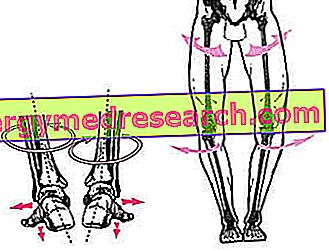By Dr. Davide Cacciola
Introduction
The foot can be considered as the terminal swab of the postural system. Because of this characteristic he deforms, twists, balances himself to harmonize the postural imbalance on the ground. This imbalance is often caused by imbalances in other receptors that affect posture (stomatognathic apparatus, sight, inner ear, etc.)
Rarely, instead, it represents the main cause of the altered posture, other times it presents mixed characteristics, both adaptive and causative.
A careful postural examination in static and dynamic carried out by an experienced therapist allows to identify the nature of the breech anomalies and the consequent suitable postural treatment.
The main breech abnormalities and postural consequences are analyzed below
Varus Foot
The varus foot is characterized by a varus talo that causes an external rotation of the tibial and femoral axes, with tendency to the varus knee and patellar hyperpressure.

This condition triggers a series of postural consequences:
- external positioning of the leg and thigh;
- external positioning of the kneecaps with consequent excessive external pressure of the knees (varus knee)
- external rotation of the femur which can cause long-term arthritis of the hip joint;
- verticalization of the sacrum and reduction of column curves with consequent flat back and flat buttocks
Various asymmetrical feet
In this case both feet are as varied as in the previous condition but they are asymmetrical.
This condition causes bascule and rotations of the pelvis to which the column will adapt to vertebral blockages at various levels or with the onset of scoliosis.
So the consequences related to varism described above in the case of various asymmetric feet are added to scoliosis or vertebral blockages
Valve feet and flat feet
The flat foot is associated with a talo valgus. The internal sagging of the foot causes an internal rotation of the tibial and femoral axes, a tendency to the knee valgus and an internal misalignment of the rotulae.
This condition triggers a series of postural consequences:
- internal positioning of the leg and thigh;
- internal positioning of the kneecaps (valgus knee);
- forward projection of the pelvis (anteversion)
- increase in lumbar lordosis (hyperlordosis)
- increase due to subsequent compensation of the other curves (dorsal hypercyphosis, lumbar hyperlordosis)

This condition causes tension in compression on all the lumbar vertebrae, general rigidity and risk of contractures.
Assymmetric valgus feet
In this case both feet are as good as in the previous condition but they are asymmetrical.
This condition causes bascule and rotations of the pelvis to which the column will adapt to vertebral blockages at various levels or with the onset of scoliosis.
So the consequences related to the valgism described above in the case of asymmetric valgus feet are added to the scoliosis or vertebral blockages
Disharmonious feet
These are two feet with opposite characteristics, one valgus and the other launching
In this case, opposite rotations of the legs will occur, which will cause one internal rotation and the other in external rotation
This condition causes bascule and rotations of the pelvis, which in turn will cause scoliosis or vertebral blockages at various levels

Double component feet
It is the same foot that presents valgating and variegating components. It is noted by studying the path forward and backwards, not in standing order.
Usually during walking this foot first rests on the outer edge of the heel, falling immediately afterwards in valgus. This condition causes the body to lean forward with possible consequences:
- excessive tension in the lumbar vertebrae
- anterior scapular plane
- goose leg tendinitis
- calf pains
- plantar pains
- claw toes and calluses to the feet
As mentioned in the introduction, it must be considered that most of the times the foot adapts to imbalances of other receptors that will be considered primarily if the problem is to be resolved definitively.



